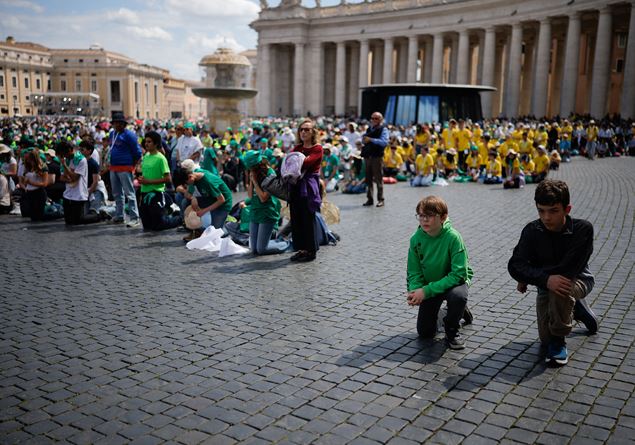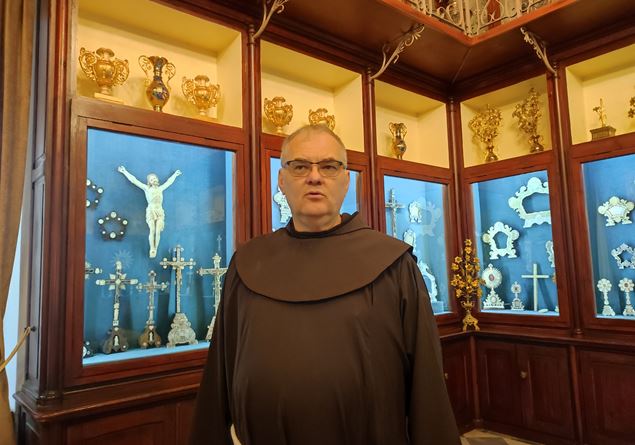“No identity research, rather a rich representation of the sharing that has lived for centuries Jerusalem, even when it is only told”: in the words of the superior of the Basilica of the Holy Sepulcher, Fratel Stefan Milosevich, This is the goal of the second large exhibition center that is being born thanks to friars of the custody of the Holy Land in the oldest heart in the city.
It is the Museum dedicated to Art and History hosted in the complex of Church of the Savior, While the archaeological one, founded in 1902 and recently modernized, is adjacent to the church of the flagellation. “It is a cultural operation in the most authentic sense because it tells the crossing of cultures,” Brother Stefan tells us, while it opens the door on salt that we feel full of meanings even if they are just painted and still empty. We announce the “short” arrival of the “majestic bas -relief of resurrection” for the entry of the museum. For the opening of the museum, however, there is no certainty.
The promise is engaging: “Those who come to the Holy Land find places originating of their faith and is the extraordinary wealth that everyone expects, but there is also an opposite dynamic: in the works that we keep in the Holy Land we find Western roots“. Unique testimonies of various historical periods that have been overwhelmed by conflicts and destruction elsewhere while “here, in the land considered too often only as an emblematic place of conflict, are preserved and preserved”.
The impression is to be within a casket where preciousness betray the splendor of the care in the provisionality of a move, while the value of memory illuminates everything.
Works and objects have been cataloged like paintings, or restored like ceramics. The decisive step of the actual setting up is missing. Fratel Stefan trusts us: “We had a setback for the escalation of violence from 7 October 2023 because” the case has decided to donate the resources for the assistance of civilians, in particular of women and children “, victims of conflicts that have several fronts in this region. The priorities are always people and it is precisely what the rich collection of jugs, pots, moods of space, pharmacopoees, recipe books and registers of medicines of the pharmacy of the monastery of San Salvatore tells us.
Fratel Stefan underlines it: “The Franciscans have edited all those who needed it from the fifteenth century: local or pilgrims, Jews and Muslims of any nationality “. It happened even while conflicts were impressed or broke out and allowed to weave “canvases of relationships”.
With an expression veiled by bitterness Brother Stefan underlines: “How many times are difficult relationships with Jews but we keep certificates of benevolence and esteem and we live it today too”. It makes us a concrete and nice example: “Many Jews visit our cellars who retain barrels and tools of the past.”
The ancient land of Canaan was a cradle and a place of spread of the cultivation of the vine two millennia before the culture of wine arrived in Europe and during the Roman and Byzantine period, the Judea and the port cities of Ashkelon and Gaza were considered centers Vitali for production, but during Muslim domain, since the law prohibits Muslim believers for drinking, it was possible to cultivate only food grapes. Between the XII and the XIII century, the Crusaders tried to replace the screws but it was easier to import the finished product from Europe. The renewal of the winemaking in Israel is from the 19th century: from here so much curiosity for missing pieces of history.
The superior of the Basilica of the Holy Sepulcher, Fratel Stefan Milosevich
In reality, Fratel Stefan clarifies us what we are actually talking about discerning wine: “We have our roots in Judaism, but they find their western human roots in these works and find them paradoxically in the churches”. We understand that western culture that is not felt in this land is alive in the heritage of this museum in Fieri. Moreover, the wine tells fragments of dialogue also with the Muslims: during the domain of the Mamelucchi and then in particular under the Ottoman one, the friars had to buy permits to produce the wine necessary for mass. Then there were the passing or authorizations to open and manage schools and many other administrative acts.
Fratel Stefan mentions “hundreds and hundreds of documents from various periods”. To impose on the sight with all the elegance and the meticulousness that distinguishes them are the work in mother of pearl and silver. And also in this case they give pieces of past and truth. These are largely given artifacts given by Muslim Arabs who had learned the art of this processing by the Franciscans themselves. The goal was to teach a job that would allow you to live and maintain a family and some of them, who have become affirmed artists abroad, have never forgotten the teachers. A work speaks for everyone: Miniature reproduction of the Holy Sepulcher.
The superior of the basilica shows us how to open and discover to put the most significant parts well. He shares a look of admiration for so much artistic refinement and happy amazement for “the relationship of respect, friendliness and even affection that hides”.
We feel the feeling of discovering unique tracks of history even more decidedly in front of the sacred vestments that Fratel Stefan shows us by extracting them from a wardrobe that manages to contain dozens and dozens. In particular, it hits the solemn farmhouse embroidered by Versailles in the mid -18th century and sent by the king to the friars to Jerusalem, before the looting on the wave of the revolution. He is woven with silk and gold threads of the best quality, as he began to the gift of the sovereign of France. With the finesse of the drawing and the strength of the colors, which preserves very lively, it is the most surprising example of artistic expressions lost in the West that can be found in the heart of Jerusalem. They are all gifts that wealthy pilgrims brought or that eminent sovereigns sent in the impossibility of coming on pilgrimage: “It was the best to offer what they had more beautiful”, underlines the superior with the Franciscan smile and the enthusiasm of the scholar.

“Also in all this we find seeds of hope to which we are all always called as Christians but which the Holy Year 2025 invites us to renew and live in depth of faith”. So Fratel Stefan encourages us to talk about these treasures testifying that “Hope is difficult but never dies and let alone in Jerusalem”.
The reasons for concern for the situation in the neighboring and Middle East are not lacking and Fratel Stefan prays so that “soon you can find the way of peace, re -deal with pilgrims and share with an audience from all parts of the world the heritage of the Terra Sancta Museum.
It is clear that the museum is not only an intellectual curiosity but it is a message: “It must be opened as open is the Church and must tell all the historical thickness of possible coexistence”. In this land – he reiterates – “For eight centuries the Church has relationships with Jewish and Muslim communities, with Christian and Muslim pilgrims and it is what we live even today despite everything, even if it is not adequately told”. Another perspective appears inverted to us. Fratel Stefan recognizes that “the Holy Land is a source of concern because there was no shortage of very difficult moments” but then it gives us a truth: “In the centuries of the centuries, rather good relationships are found”.
He tells us about his daily life: “As a superior of the Basilica of the Holy Sepulcher I have relationships with everyone and this year, for example, I am a professor at the Seminary of the Orthodox Greeks, while according to the mass media it would seem that Catholics, Orthodox, Greeks, Copts, Syriacs , are always in the lit Lite with each other ”.
Fratel Stefan reminds us that “The Christians did not divide to the Holy Sepulcher but divided into Ephesus, Calcedonia, in Europe” And he underlines that “the Holy Sepulcher is a place where people distant elsewhere find themselves together”. Also Jerusalem – assures us greeting us – “is not the place you divide, but the place where you live together”.








